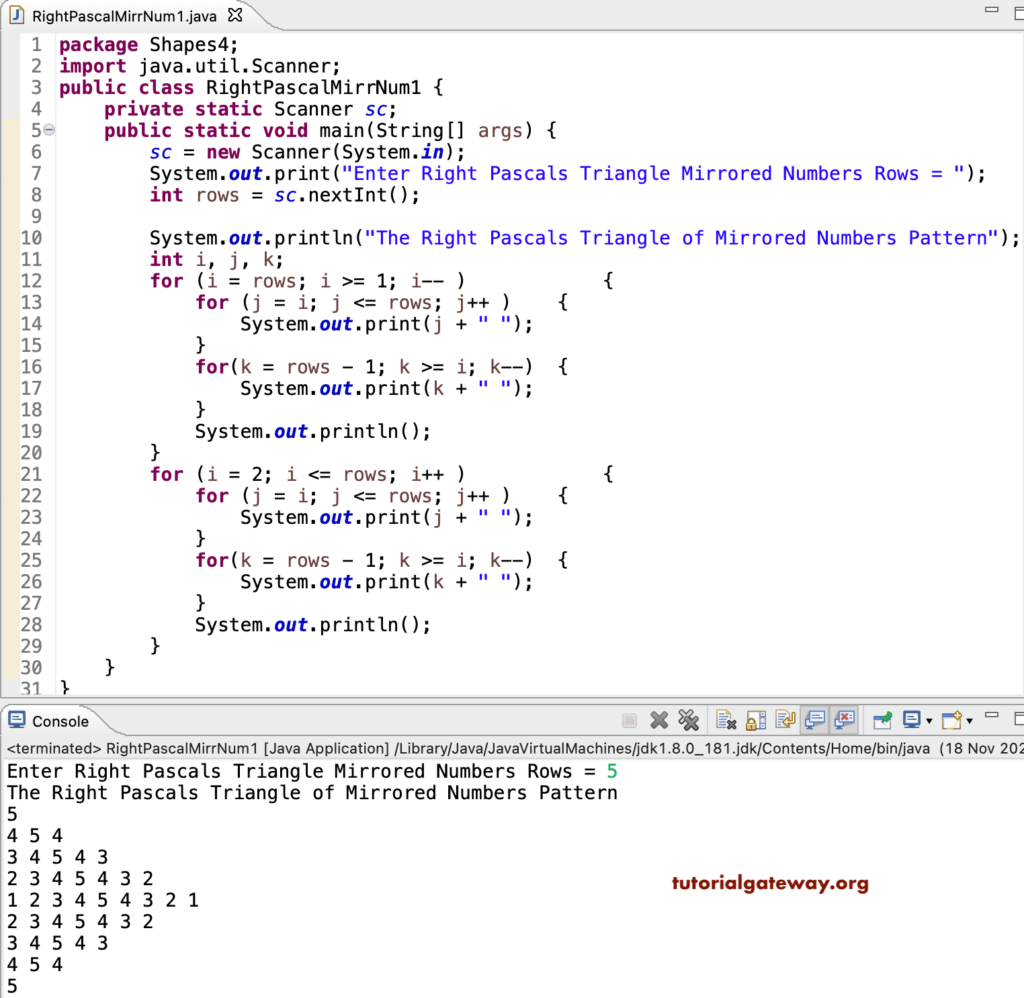Write a Java program to print right pascals triangle of mirrored numbers pattern using for loop.
package Shapes4;
import java.util.Scanner;
public class RightPascalMirrNum1 {
private static Scanner sc;
public static void main(String[] args) {
sc = new Scanner(System.in);
System.out.print("Enter Right Pascals Triangle Mirrored Numbers Rows = ");
int rows = sc.nextInt();
System.out.println("The Right Pascals Triangle of Mirrored Numbers Pattern");
int i, j, k;
for (i = rows; i >= 1; i-- )
{
for (j = i; j <= rows; j++ )
{
System.out.print(j + " ");
}
for(k = rows - 1; k >= i; k--)
{
System.out.print(k + " ");
}
System.out.println();
}
for (i = 2; i <= rows; i++ )
{
for (j = i; j <= rows; j++ )
{
System.out.print(j + " ");
}
for(k = rows - 1; k >= i; k--)
{
System.out.print(k + " ");
}
System.out.println();
}
}
}

This Java program prints the right pascals triangle pattern of mirrored numbers using a while loop.
package Shapes4;
import java.util.Scanner;
public class RightPascalMirrNum2 {
private static Scanner sc;
public static void main(String[] args) {
sc = new Scanner(System.in);
System.out.print("Enter Rows = ");
int rows = sc.nextInt();
System.out.println("The Right Pascals Triangle of Mirrored Numbers Pattern");
int i, j, k;
i =rows;
while(i >= 1 )
{
j = i;
while(j <= rows )
{
System.out.print(j + " ");
j++;
}
k = rows - 1;
while( k >= i)
{
System.out.print(k + " ");
k--;
}
System.out.println();
i--;
}
i = 2;
while(i <= rows )
{
j = i;
while(j <= rows )
{
System.out.print(j + " ");
j++;
}
k = rows - 1;
while( k >= i)
{
System.out.print(k + " ");
k--;
}
System.out.println();
i++;
}
}
}
Enter Rows = 11
The Right Pascals Triangle of Mirrored Numbers Pattern
11
10 11 10
9 10 11 10 9
8 9 10 11 10 9 8
7 8 9 10 11 10 9 8 7
6 7 8 9 10 11 10 9 8 7 6
5 6 7 8 9 10 11 10 9 8 7 6 5
4 5 6 7 8 9 10 11 10 9 8 7 6 5 4
3 4 5 6 7 8 9 10 11 10 9 8 7 6 5 4 3
2 3 4 5 6 7 8 9 10 11 10 9 8 7 6 5 4 3 2
1 2 3 4 5 6 7 8 9 10 11 10 9 8 7 6 5 4 3 2 1
2 3 4 5 6 7 8 9 10 11 10 9 8 7 6 5 4 3 2
3 4 5 6 7 8 9 10 11 10 9 8 7 6 5 4 3
4 5 6 7 8 9 10 11 10 9 8 7 6 5 4
5 6 7 8 9 10 11 10 9 8 7 6 5
6 7 8 9 10 11 10 9 8 7 6
7 8 9 10 11 10 9 8 7
8 9 10 11 10 9 8
9 10 11 10 9
10 11 10
11 In this Java pattern example, we used the rightpascalMirrored function to separate the for loop login and display the right pascals mirrored numbers triangle.
package Shapes4;
import java.util.Scanner;
public class RightPascalMirrNum3 {
private static Scanner sc;
public static void main(String[] args) {
sc = new Scanner(System.in);
System.out.print("Enter Rows = ");
int rows = sc.nextInt();
System.out.println("");
int i;
for (i = rows; i >= 1; i-- )
{
rightpascalMirrored(rows, i);
System.out.println();
}
for (i = 2; i <= rows; i++ )
{
rightpascalMirrored(rows, i);
System.out.println();
}
}
public static void rightpascalMirrored(int rows, int i) {
for (int j = i; j <= rows; j++ )
{
System.out.print(j + " ");
}
for(int k = rows - 1; k >= i; k--)
{
System.out.print(k + " ");
}
}
}
Enter Rows = 13
13
12 13 12
11 12 13 12 11
10 11 12 13 12 11 10
9 10 11 12 13 12 11 10 9
8 9 10 11 12 13 12 11 10 9 8
7 8 9 10 11 12 13 12 11 10 9 8 7
6 7 8 9 10 11 12 13 12 11 10 9 8 7 6
5 6 7 8 9 10 11 12 13 12 11 10 9 8 7 6 5
4 5 6 7 8 9 10 11 12 13 12 11 10 9 8 7 6 5 4
3 4 5 6 7 8 9 10 11 12 13 12 11 10 9 8 7 6 5 4 3
2 3 4 5 6 7 8 9 10 11 12 13 12 11 10 9 8 7 6 5 4 3 2
1 2 3 4 5 6 7 8 9 10 11 12 13 12 11 10 9 8 7 6 5 4 3 2 1
2 3 4 5 6 7 8 9 10 11 12 13 12 11 10 9 8 7 6 5 4 3 2
3 4 5 6 7 8 9 10 11 12 13 12 11 10 9 8 7 6 5 4 3
4 5 6 7 8 9 10 11 12 13 12 11 10 9 8 7 6 5 4
5 6 7 8 9 10 11 12 13 12 11 10 9 8 7 6 5
6 7 8 9 10 11 12 13 12 11 10 9 8 7 6
7 8 9 10 11 12 13 12 11 10 9 8 7
8 9 10 11 12 13 12 11 10 9 8
9 10 11 12 13 12 11 10 9
10 11 12 13 12 11 10
11 12 13 12 11
12 13 12
13 